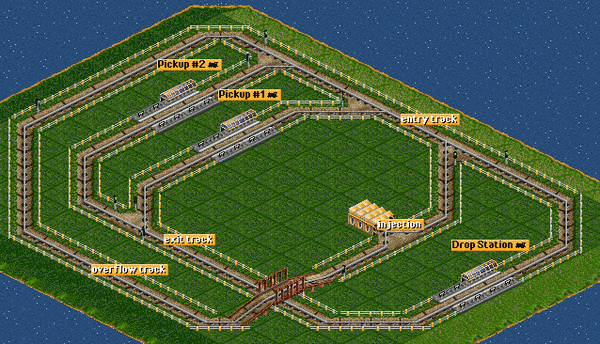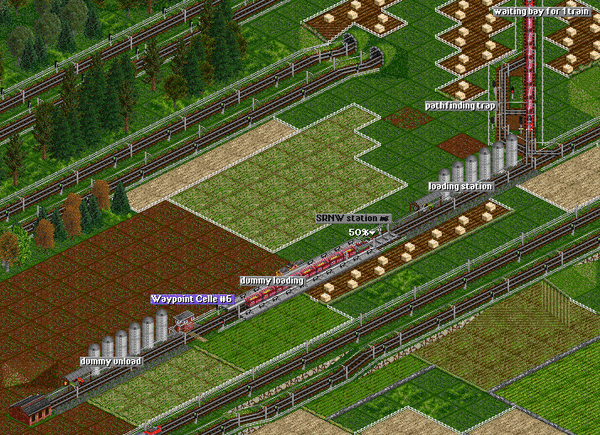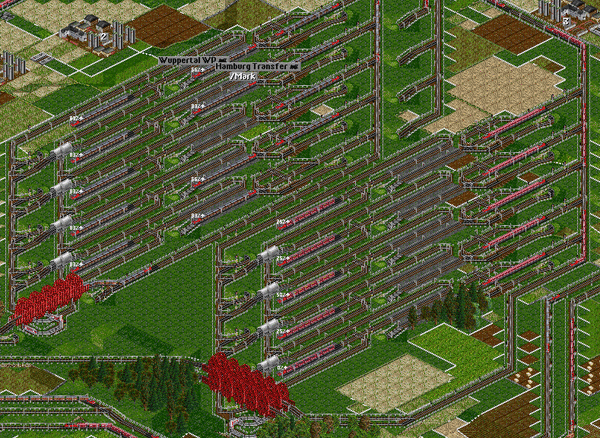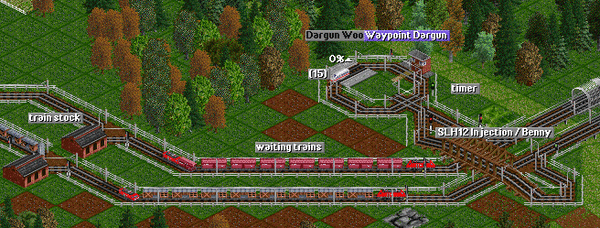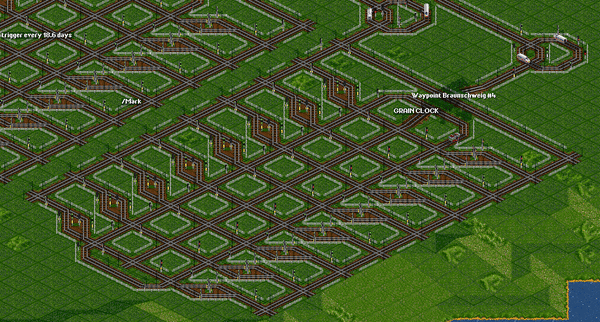Difference between revisions of "Self-regulating Network"
From #openttdcoop wiki
(Categories) |
|||
| Line 66: | Line 66: | ||
*Bigger stations are hard to build. | *Bigger stations are hard to build. | ||
*Takes up quite some space. | *Takes up quite some space. | ||
| − | *Only transports a few | + | *Only transports a few cargo types. |
| + | |||
| + | |||
| + | [[Category:Guides]] | ||
| + | [[Category:Advanced Networking]] | ||
Revision as of 08:34, 16 March 2012
Idea
Self-regulating Networks, or SRNW for short, are a type of networks invented by the #Openttdcoop community. The idea behind it is that trains on a network share orders, so there is a group of trains per network and not per station. In theory, this should reduce the overhead of making sure all stations have the right amount of trains. In practice, even though the network will still be divided, this proves to be the case. However, it does introduce other issues.
Design
A typical SRNW line will consist of
- a drop station, possibly shared with other line. In this case lines are split with waypoints.
- an entrance track.
- an exit track.
- an overflow track.
- an injection system.
- one or more SRNW-type stations.
For the line to work, there are a few basic but important rules:
- Trains can only get to the drop through a pickup station.
- A train should only enter a pickup station when there is enough cargo to pickup.
- Trains that can not enter a station overflow back to the start.
- New trains should be introduced intermittently.
Orders
All trains on a line share the same orders. On a standard line, this is just one go-to to the drop station. Caution: this order can not be non-stop. When lines share a drop station, every group should get an entry and exit waypoint at the start and end of the non-shared line.
Stations
The stations of the SRNW are one of its biggest drawbacks. To prevent trains from clogging the first station and driving around empty, stations should only let trains enter when there is a full load waiting. To solve this problem, all trains have a waiting bay. This ensures that when there is a full load, there is a train to transport it. Furthermore, all stations have a dummy train. This dummy full-loads, blocking the waiting train. Only when it is full and moves away to unload can a train enter the station and pickup the cargo. Even though this works, it does prove to be quite a hassle, especially for larger stations.
A special note on the pathfinding trap: sometimes trains refuse to enter the station. This construction fools the pathfinder into thinking it can reach the drop station by driving through there. Can be required on lines with a roro station or a non-reversing overflow (aka continuous track). Also, when the production grows, so should the station. This can lead to huge constructions, as demonstrated below by Mark.
Feeder Loop
Feeder loops are an alternative to pickup stations using dummy trains. Instead of dummy trains they use feeder trains with conditional orders that allow a "real" train to enter the station if a full feeder train has unloaded. This page introduces the concept, including some images and a link to a savegame with a working feeder loop.
Injection
Injection is the system of re-introducing trains to the network. Trains from a depot, and therefore from the overflow track, are sent back onto the entry track. The easiest way to do this is to release a train every X days by using a loop, a station and a little train.
This idea can be extended by
- not releasing a new train when one has just overflown. (ODM)
- not releasing a new train when all waiting bays are full. (Osai)
- resetting the train release timer when a train overflows. (Mark)
Advantages
- A well structured network by design.
- High efficiency.
- Keeping the amount of trains right just by checking the depot stock.
Disadvantages
- Bigger stations are hard to build.
- Takes up quite some space.
- Only transports a few cargo types.
